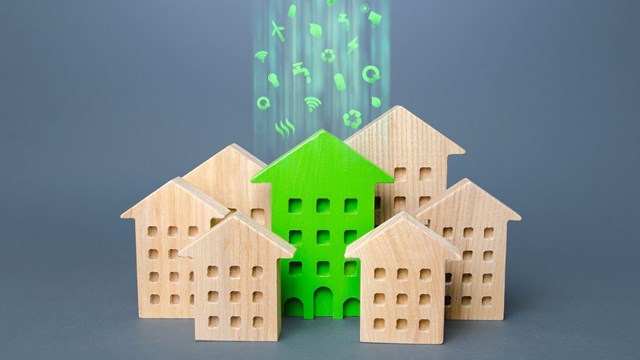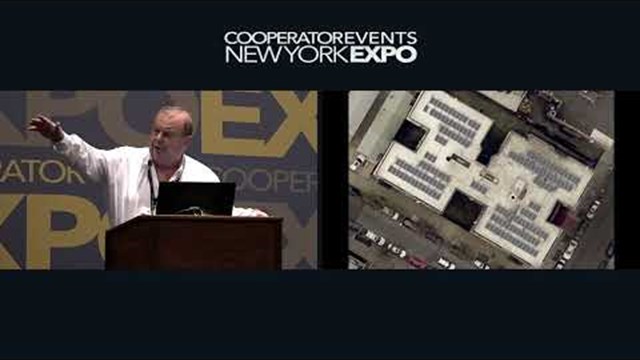Perhaps the most pressing long-term issue for our society and the planet as a whole is the threat posed by climate change. While some may still deny the established facts, the reality remains that the world is warming at an unprecedented - and unsustainable - rate, with the blame for this resting squarely on human activity based around fossil fuels. Both the effects and the responsibility for countering those effects fall heavily on the real estate industry. All sectors–residential, commercial, office, and manufacturing–contribute to climate change, and share the responsibility to counter it by adjusting and refining how we heat, cool, and ventilate our properties. In the world of shared interest communities like co-ops and condos, those factors are paramount to how we plan our futures. Much has been done already, and much is yet to be done. When it comes to greener technology, what’s been successful, and what’s coming down the road? What was considered a breakthrough yesterday may be obsolete tomorrow.
Undervalued & Overlooked
Perhaps the most efficient (though often overlooked) way to save on energy and counter climate change is conservation, plain and simple, explains Fred Goldner, president of Energy Management & Research Associates located in East Meadow, New York. Goldner consults with companies and governments all over the globe, and according to him, “The truth is that the greenest thing you can do is to achieve energy efficiency for your property. And achieving that should be done before any of the other projects that can and should be undertaken to improve your carbon footprint. Unfortunately however, the vast majority of property owners–including condominium, co-op, and HOA communities–have not done their homework when it comes to efficiency. The key is conservation–all the things we’ve been talking about for 40 years.”
Richard Costello, president of Acela Energy Group, located in Norfolk, Massachusetts agrees. He sees efficiency and conservation as the starting point to controlling and reducing your building’s energy usage. Like Goldner, he recommends getting energy usage under control before employing new technology. “For conservation in individual units,” he says, “the best thing you can do is to control both heating and cooling to control energy consumption. Get a digital thermostat; it’s the single most important thing one can do. Most residences in New England will have some kind of HVAC system, either individual to the unit or part of a main system for the building. Installing digital thermostats and letting them do their job will save money as well as energy. That means that individual residents cannot override the system. Let it work. Don’t change it to your comfort level.”
Another potential site for improving efficiency and conservation is metering. For the first two-thirds of the 20th century, master metering –meaning one utility meter for the entire building–was the standard in virtually all apartment buildings. When energy costs began to skyrocket in the 1970s and 1980s, new buildings were constructed with individual meters for each unit, and the tenant or owner became responsible for the cost of their own utility use–electricity in particular, and sometimes for heat as well. Many existing properties converted from master to individual metering, with municipal utility providers like Con Edison offering financial assistance for these conversions in New York City.
Kyle MacKenzie, a principal of Polise Consulting Engineers, a national company with offices in New York City, notes that the push for individual metering has completely reversed. “For existing buildings,” he says, “one item that could and should be reviewed from a cost savings perspective is converting from direct or individual metering to master meeting. Instead of billing directly to each apartment, one meter measures usage for the whole building. Master metering is better, since the total cost of electricity offered by utility companies is often lower using this method. This is especially beneficial in a co-op or condo where the savings would be spread throughout the community. In New York for example, ConEd’s rate structure provides a better rate for master metering over small accounts.”
New Strategies, New Technologies
According to Goldner, once conservation measures are implemented, the number one new technology to consider is hydrogen. “All major gas utilities are doing pilot projects or research into using hydrogen as a fuel,” he says. “I’m not saying that it’s a singular answer to the energy problem; no complex problem has been solved by one size fits all answer. But hydrogen as a fuel will be part of the answer. Gas Technology Institute (GTI) in Chicago has tested all kinds of appliances running on natural gas with a 30% hydrogen combination, and most can operate on that combination without changing or altering the equipment.”
Another promising technology according to Goldner is something called carbon capture. “You can take an existing gas boiler, and install a component that acts as a scrubber in the stack, pulling out the CO2 and liquifying it. The liquified CO2 can then be sold to hospitals who need and use it, or can be encased in concrete, and it’s gone forever.”
Costello recommends joining what’s called a community solar company. “A community solar company builds solar facilities in what would otherwise be unused areas, such as on the sides of highways,” he explains. “The panels generate electricity. Your association signs up with a community solar company, and they ‘assign’ you to a large solar panel. You ‘pretend’ that it’s yours–the electricity generated by the panel doesn’t actually get sent to you or used by you–but the utility takes 10-15% off your electric bill. It’s literally a freebee.”
However, he points out that “This program has nothing to do with energy savings. It’s free money–that’s it. If you want to go carbon neutral by a certain date, you need huge investment in equipment and capacity. States want utilities to do something like this to build the equipment along say, a highway. Ultimately, energy is what’s being traded here.”
“Essentially,” Costello explains, “your community volunteers to take the energy, though you’re not really taking it. The utility can then get financing to build the solar farms, and they sell the energy elsewhere. Volunteering to take it gets the facility built, and your bill reduced by anywhere from 10 to 15 percent. It’s a 20-year program, and will not reduce your community’s actual carbon footprint, though it does save you some money.”
MacKenzie recommends using energy recovery ventilators (ERVs) as a means of freshening air and assisting HVAC systems. “ERVs bring in fresh air, and remove exhaust,” he says. “There’s an energy exchange, so in the winter the air gets warmed by the exhaust, and during the summer the hot fresh air loses some of its energy through the exhaust exchange process, making much less work for the HVAC system. While the installation of ERVs is certainly more costly than standard fresh air fans or other old-fashioned ways of doing things, it will help meet climate regulation goals such as those required in New York City by Local Law 97. Although the initial costs are higher, operational costs are lower. In the future, it’s likely users will be driven to these systems by local government requirements anyway.”
Electrification - Pros & Cons
A major component of many government programs designed to battle climate change is a conversion from the use of fossil fuels for HVAC to electrification of these systems. While electrification may be better for the planet, the truth is that this conversion is a very difficult and expensive undertaking.
According to Goldner, “Rather than ripping out all existing equipment, such as our boilers and radiator systems to put in heat pumps, using hydrogen fuels in our boilers or running them on natural gas and employing carbon capture may be a better, more affordable alternative, because you keep the boiler and heating distribution system that you already have. It’s much less costly to accomplish, and there’s much less damage to lives and property.”
Costello believes that the future is efficiency over electrification. “Electrification costs too much,” he says. “Instead install an artificial intelligence (AI) system to improve the operating efficiency of your boiler. The payback on an AI system is three years without any incentives from a public utility. The payback on electrification is 15 years–10 years with incentives. In the end, electrification doesn’t save energy–it just uses it differently.”
MacKenzie supports these arguments. “The upfront costs of fully electrifying and adding energy efficiency measures can greatly offset the benefit of the energy efficiency measures,” he says. “There is a need for a life cycle cost-and-benefit analysis to determine if the conversion is worth it. The problem is that today we are required by law to reduce our carbon footprint. You’d be fined if you didn’t do so. The truth is that sometimes even the fine can be less than the cost [of compliance].”
The future of energy technology and conservation is still developing. We can expect changes to current thinking and material technology as we go forward, so it’s vital for boards and managers to do their own homework and consult with competent, knowledgeable experts in the field to map out the path forward that makes the most financial and environmental sense for their own communities.
A J Sidransky is a staff writer/reporter for CooperatorNews, and a published novelist. He may be reached at alan@yrinc.com.










Leave a Comment